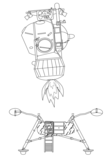 | |
| Manufacturer | Korolev |
|---|---|
| Country of origin | Soviet Union |
| Operator | Soviet space program |
| Applications | Uncrewed spacecraft around the Moon and back to Earth |
| Production | |
| Status | Program ended. One craft orbited, one craft failed |
| Built | 2 |
| Launched | 2 |
| Retired | 1971 |
| Related spacecraft | |
| Derived from | Soyuz 7K-OK and Soyuz 7K-L1 |

Soyuz 7K-L1E was a Soviet uncrewed modified Soyuz 7K-L1 spacecraft. Also called a dummy Soyuz 7K-LOK. Two were built, one Soyuz 7K-L1E was successfully launched into Low Earth Orbit on Proton rocket and is known as Kosmos 382. The other Soyuz 7K-L1E was placed on a N1 rocket, which failed at launch. The Soyuz spacecraft was first used in 1967 as the main crewed spacecraft and is still in use. Many Soyuz variations have been built and the Soyuz 7K-L1E was an uncrewed variation.
Soyuz 7K-L1E No.1
Main article: Soyuz 7K-L1E N-1Soyuz 7K-L1E No.1 was launched on 26 June 1971 at 23:15:08 (11:15pm Moscow time) from Baikonur Cosmodrome Site 110/37. The spacecraft was built to test the Blok D rocket and the N-1 rocket. This was the third launch of the N-1. The previous two N-1 launches had failed. The N-1 Rocket was a super heavy-lift launch vehicle design to go to the moon, as a counterpart to the U.S. Saturn V rocket in the space race. The first stage of the N-1 serial 6L failed at launch. The Soyuz 7K-L1E had no escape rescue system and was lost. The Block D was designed to work with the N-1 to take the LK lunar lander to near the surface of the Moon. The Block D stage is still in use, but is used atop a Proton rocket. Had Soyuz 7K-L1E No.1 worked the upper stage was planned to go through maneuvers simulating those that would be used on a lunar mission. The Block D rocket would have taken the LK lunar lander to near the surface of the Moon.
Soyuz 7K-L1E No.2
Main article: Kosmos 382Soyuz 7K-L1E No.2 was an uncrewed Soyuz 7K-L1, launched on a Proton, with an N-1 upper stage and the Soyuz 7K-L1E control spacecraft into Earth orbit on 2 December 1970. This flight was a success and was then designated "Cosmos 382" - "Kosmos 382". Kosmos being the title given Soviet satellites since 1962. Kosmos-382 carried experiments and simulating the lunar orbit insertion burn, for planned later crewed missions to the Moon.
See also
References
- Portree, David (March 1995). "Mir Hardware Heritage" (PDF). NASA. Archived from the original (PDF) on 7 September 2009. Retrieved 24 August 2012.
- RSC Energia: Concept Of Russian Manned Space Navigation Development
- NASA - Russian Soyuz TMA Spacecraft Details
- Space Adventures circum-lunar mission - details
- NASA, Russian Proton-K completes 45 years of service with US-KMO satellite launch, by William Graham March 29, 2012
- airvectors.net, THE SOVIET MOON PROGRAM IN THE SHADOW OF APOLLO
- "Zond (L1E)". space.skyrocket.de.
- "Публикации сотрудников АО "НИИхиммаш"" [Life Support Regeneration Systems for Long Space Flights (Publications by employees of JSC NIIhimmash)]. www.niichimmash.ru.
External links
| Soviet crewed lunar programs | ||
|---|---|---|
| Launch vehicles and ascent/upper stages |  | |
| Spacecraft | ||
| Other hardware | ||
| Soyuz docking tests | ||
| Zond (7K-L1/L1S) lunar flyby missions | ||
| LOK (7K-LOK/L1E) test missions | ||
| LK Lander (T2K) test missions | ||
| The † sign designates failed missions. Italics designates cancelled missions. | ||
| Soviet and Russian space program | |||||||||
|---|---|---|---|---|---|---|---|---|---|
| Launch sites |  | ||||||||
| Launch vehicles | |||||||||
| Human spaceflight programs |
| ||||||||
| Robotic programs |
| ||||||||
| Communications |
| ||||||||
| Concepts | |||||||||
| Images and artwork | |||||||||
| Related | |||||||||